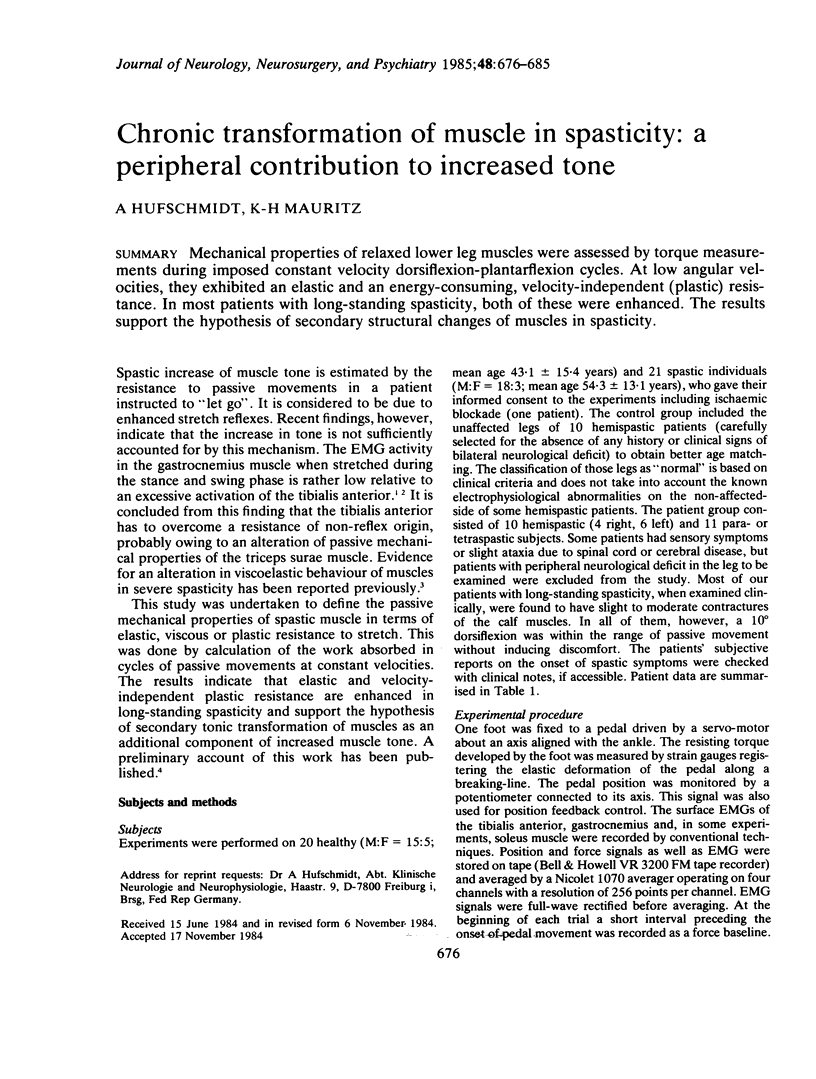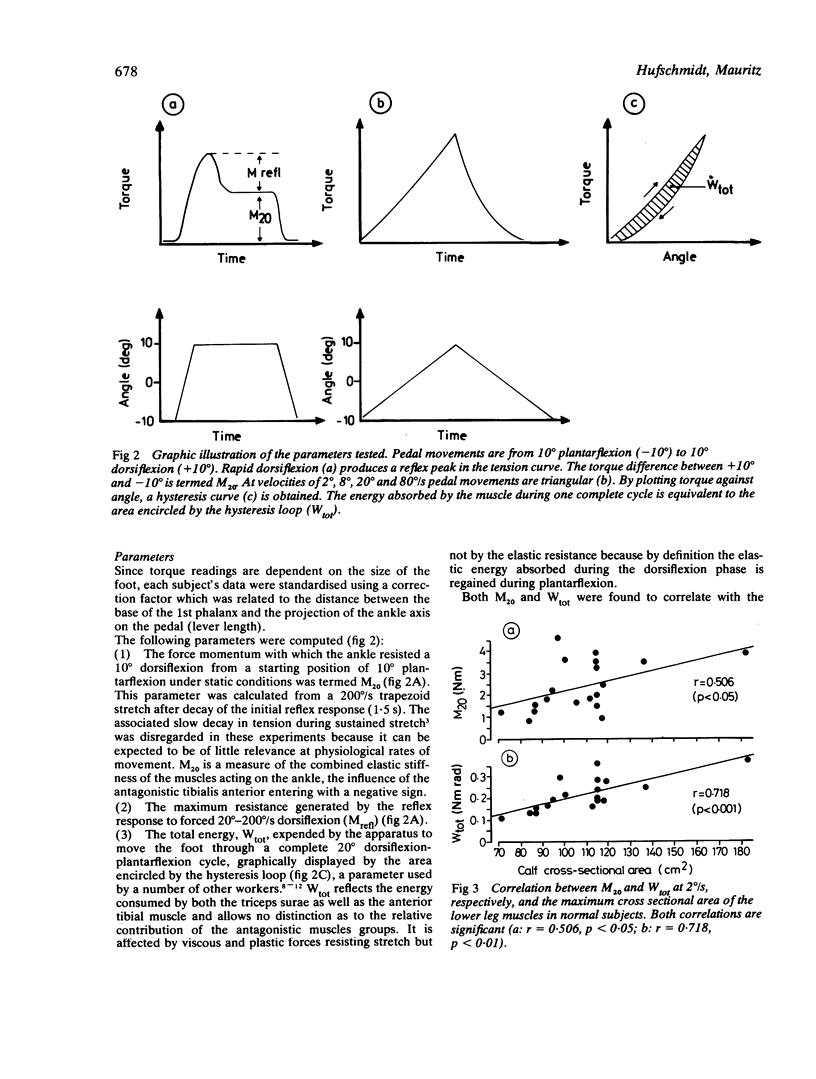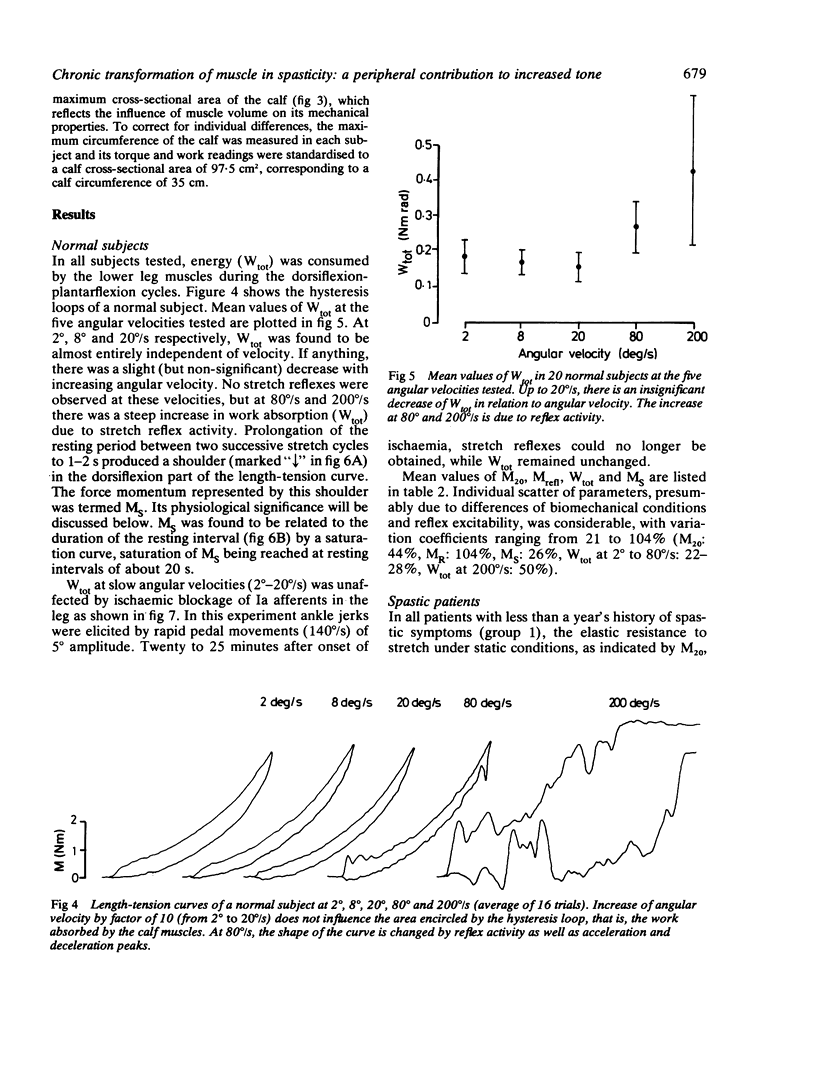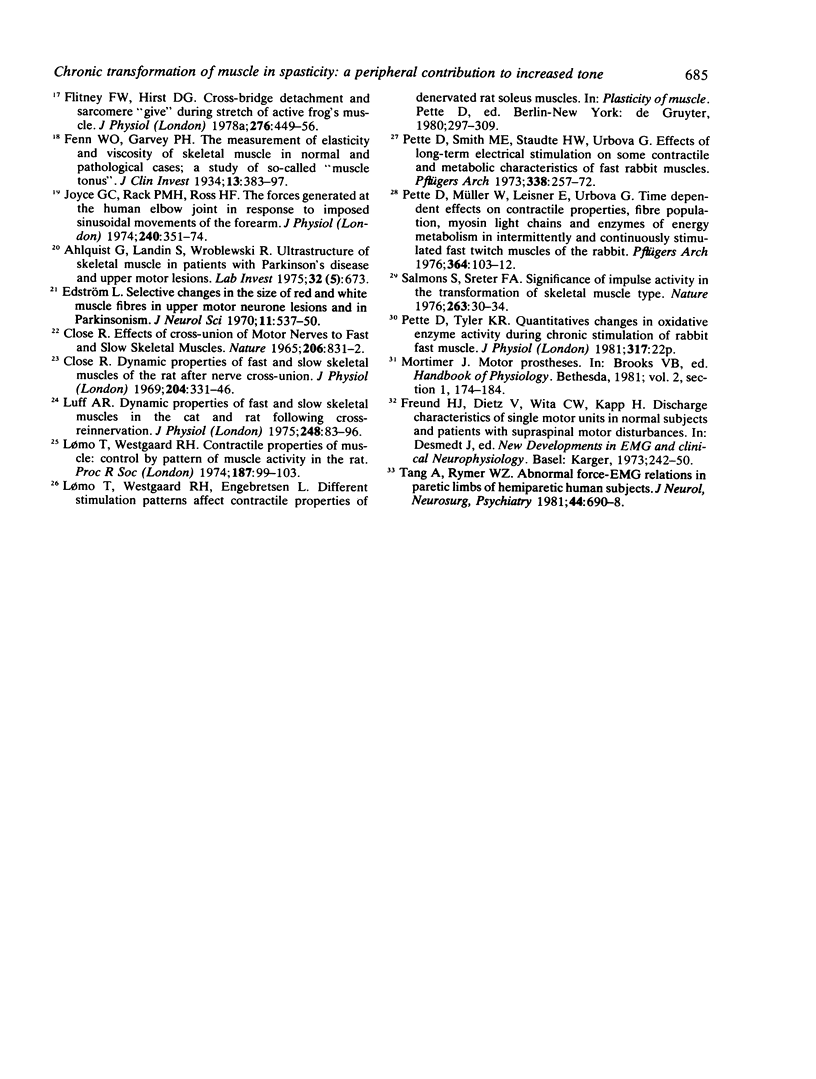Abstract
Mechanical properties of relaxed lower leg muscles were assessed by torque measurements during imposed constant velocity dorsiflexion-plantarflexion cycles. At low angular velocities, they exhibited an elastic and an energy-consuming, velocity-independent (plastic) resistance. In most patients with long-standing spasticity, both of these were enhanced. The results support the hypothesis of secondary structural changes of muscles in spasticity.
Full text
PDF









Selected References
These references are in PubMed. This may not be the complete list of references from this article.
- Ahlqvist G., Landin S., Wroblewski R. Ultrastructure of skeletal muscle in patients with Parkinson's disease and upper motor lesions. Lab Invest. 1975 May;32(5):673–679. [PubMed] [Google Scholar]
- Chokroverty S., Medina J. Electrophysiological study of hemiplegia. Motor nerve conduction velocity, brachial plexus latency, and electromyography. Arch Neurol. 1978 Jun;35(6):360–363. doi: 10.1001/archneur.1978.00500300034005. [DOI] [PubMed] [Google Scholar]
- Close R. Dynamic properties of fast and slow skeletal muscles of the rat after nerve cross-union. J Physiol. 1969 Oct;204(2):331–346. doi: 10.1113/jphysiol.1969.sp008916. [DOI] [PMC free article] [PubMed] [Google Scholar]
- Close R. Effects of cross-union of motor nerves to fast and slow skeletal muscles. Nature. 1965 May 22;206(4986):831–832. doi: 10.1038/206831a0. [DOI] [PubMed] [Google Scholar]
- Dietz V., Berger W. Normal and impaired regulation of muscle stiffness in gait: a new hypothesis about muscle hypertonia. Exp Neurol. 1983 Mar;79(3):680–687. doi: 10.1016/0014-4886(83)90032-8. [DOI] [PubMed] [Google Scholar]
- Dietz V., Quintern J., Berger W. Electrophysiological studies of gait in spasticity and rigidity. Evidence that altered mechanical properties of muscle contribute to hypertonia. Brain. 1981 Sep;104(3):431–449. doi: 10.1093/brain/104.3.431. [DOI] [PubMed] [Google Scholar]
- Duggan T. C., McLellan D. L. Technical contribution. Measurement of muscle tone: a method suitable for clinical use. Electroencephalogr Clin Neurophysiol. 1973 Dec;35(6):654–658. doi: 10.1016/0013-4694(73)90220-4. [DOI] [PubMed] [Google Scholar]
- Edström L. Selective changes in the sizes of red and white muscle fibres in upper motor lesions and Parkinsonism. J Neurol Sci. 1970 Dec;11(6):537–550. doi: 10.1016/0022-510x(70)90104-8. [DOI] [PubMed] [Google Scholar]
- Fenn W. O., Garvey P. H. THE MEASUREMENT OF THE ELASTICITY AND VISCOSITY OF SKELETAL MUSCLE IN NORMAL AND PATHOLOGICAL CASES; A STUDY OF SOCALLED "MUSCLE TONUS". J Clin Invest. 1934 May;13(3):383–397. doi: 10.1172/JCI100592. [DOI] [PMC free article] [PubMed] [Google Scholar]
- Flitney F. W., Hirst D. G. Cross-bridge detachment and sarcomere 'give' during stretch of active frog's muscle. J Physiol. 1978 Mar;276:449–465. doi: 10.1113/jphysiol.1978.sp012246. [DOI] [PMC free article] [PubMed] [Google Scholar]
- Flitney F. W., Hirst D. G. Filament sliding and energy absorbed by the cross-bridge in active muscle subjected to cycical length changes. J Physiol. 1978 Mar;276:467–479. doi: 10.1113/jphysiol.1978.sp012247. [DOI] [PMC free article] [PubMed] [Google Scholar]
- Gottlieb G. L., Agarwal G. C., Jaeger R. J. Response to sudden torques about ankle in man: V effects of peripheral ischemia. J Neurophysiol. 1983 Jul;50(1):297–312. doi: 10.1152/jn.1983.50.1.297. [DOI] [PubMed] [Google Scholar]
- Herman R. The myotatic reflex. Clinico-physiological aspects of spasticity and contracture. Brain. 1970;93(2):273–312. doi: 10.1093/brain/93.2.273. [DOI] [PubMed] [Google Scholar]
- Hill D. K. Tension due to interaction between the sliding filaments in resting striated muscle. The effect of stimulation. J Physiol. 1968 Dec;199(3):637–684. doi: 10.1113/jphysiol.1968.sp008672. [DOI] [PMC free article] [PubMed] [Google Scholar]
- Jiménez-Pabón E., Nelson R. A. Quantitative measurements of muscle tone in cats. Neurology. 1965 Dec;15(12):1120–1126. doi: 10.1212/wnl.15.12.1120. [DOI] [PubMed] [Google Scholar]
- Joyce G. C., Rack P. M., Ross H. F. The forces generated at the human elbow joint in response to imposed sinusoidal movements of the forearm. J Physiol. 1974 Jul;240(2):351–374. doi: 10.1113/jphysiol.1974.sp010614. [DOI] [PMC free article] [PubMed] [Google Scholar]
- Lomo T., Westgaard R. H., Dahl H. A. Contractile properties of muscle: control by pattern of muscle activity in the rat. Proc R Soc Lond B Biol Sci. 1974 Aug 27;187(1086):99–103. doi: 10.1098/rspb.1974.0064. [DOI] [PubMed] [Google Scholar]
- Luff A. R. Dynamic properties of fast and slow skeletal muscles in the cat and rat following cross-reinnervation. J Physiol. 1975 Jun;248(1):83–96. doi: 10.1113/jphysiol.1975.sp010963. [DOI] [PMC free article] [PubMed] [Google Scholar]
- MAGLADERY J. W., McDOUGAL D. B., Jr, STOLL J. Electrophysiological studies of nerve and reflex activity in normal man. II. The effects of peripheral ischemia. Bull Johns Hopkins Hosp. 1950 May;86(5):291–312. [PubMed] [Google Scholar]
- Matthews P. B. The dependence of tension upon extension in the stretch reflex of the soleus muscle of the decerebrate cat. J Physiol. 1959 Oct;147(3):521–546. doi: 10.1113/jphysiol.1959.sp006260. [DOI] [PMC free article] [PubMed] [Google Scholar]
- Pette D., Müller W., Leisner E., Vrbová G. Time dependent effects on contractile properties, fibre population, myosin light chains and enzymes of energy metabolism in intermittently and continuously stimulated fast twitch muscles of the rabbit. Pflugers Arch. 1976 Jul 30;364(2):103–112. doi: 10.1007/BF00585177. [DOI] [PubMed] [Google Scholar]
- Pette D., Smith M. E., Staudte H. W., Vrbová G. Effects of long-term electrical stimulation on some contractile and metabolic characteristics of fast rabbit muscles. Pflugers Arch. 1973 Feb 6;338(3):257–272. doi: 10.1007/BF00587391. [DOI] [PubMed] [Google Scholar]
- Rack P. M. The behaviour of a mammalian muscle during sinusoidal stretching. J Physiol. 1966 Mar;183(1):1–14. doi: 10.1113/jphysiol.1966.sp007848. [DOI] [PMC free article] [PubMed] [Google Scholar]
- Rack P. M., Westbury D. R. The short range stiffness of active mammalian muscle and its effect on mechanical properties. J Physiol. 1974 Jul;240(2):331–350. doi: 10.1113/jphysiol.1974.sp010613. [DOI] [PMC free article] [PubMed] [Google Scholar]
- SCHENCK E., BAYER H. Die Wirkung künstlicher Zirkulationsunterbreechung in der Peripherie auf Eigenreflexe beim Menschen. Dtsch Z Nervenheilkd. 1951;165(1):90–108. [PubMed] [Google Scholar]
- Salmons S., Sréter F. A. Significance of impulse activity in the transformation of skeletal muscle type. Nature. 1976 Sep 2;263(5572):30–34. doi: 10.1038/263030a0. [DOI] [PubMed] [Google Scholar]
- Tang A., Rymer W. Z. Abnormal force--EMG relations in paretic limbs of hemiparetic human subjects. J Neurol Neurosurg Psychiatry. 1981 Aug;44(8):690–698. doi: 10.1136/jnnp.44.8.690. [DOI] [PMC free article] [PubMed] [Google Scholar]


